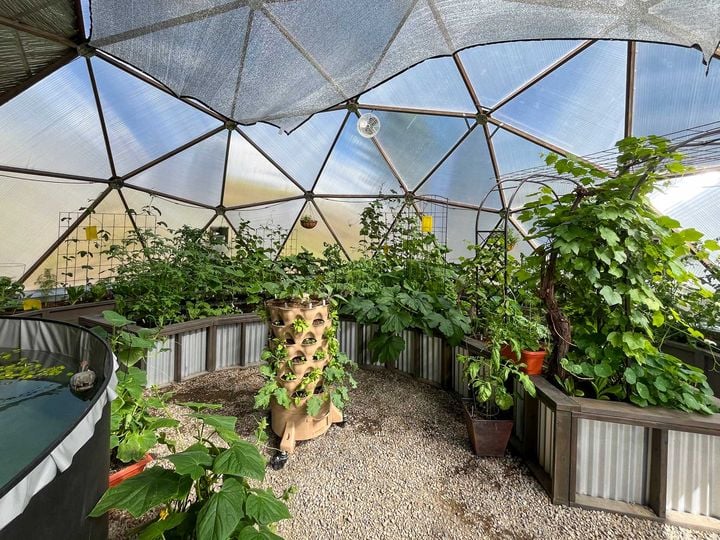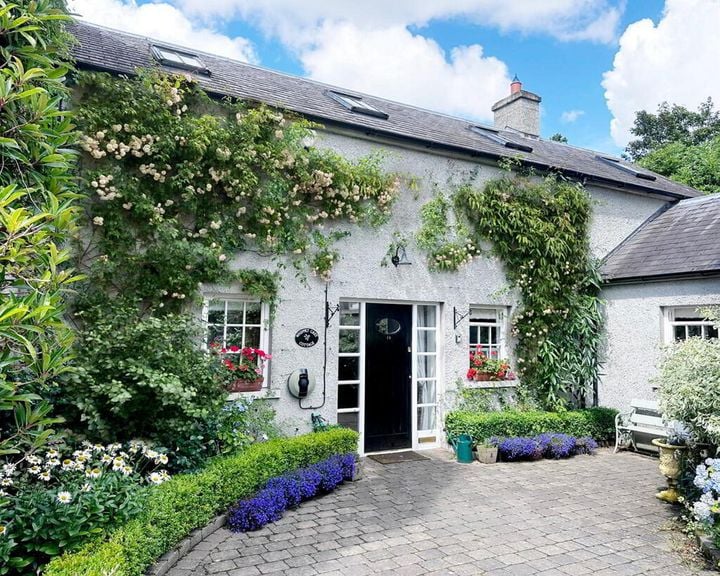
When the planting was complete, some huge greenhouse domes would be dropped over the plots. They’d be left for a couple of months and then contestants and judges would return, the domes would be lifted, and the gardens examined. The one that had ‘cooked’ the best — that is, the one where the plantings had evolved in the most magnificent of ways — would win.
The series was never made, but I became intrigued by biodomes. Greenhouses of whatever shape will accelerate the growth of the plants that live inside. They can also allow us to grow plants which otherwise may be too tender for our sometimes cold climate.

They can elongate the summer season to allow tomatoes to ripen and create great spaces for growing your own vines. A heated greenhouse may allow you to grow an extraordinary range of tender plants that have originated in warmer climes. But if you have an interesting-shaped greenhouse, a geodesic dome, how do you go about it? That was the question put to me by Mary and Oistín from west Cork, who have recently installed a geodome in their garden.
They’ve furnished it with a hammock and beanbags but they also wish to create a place where plants bring in a sense of drama, wonder and transformation across the seasons. A geodome is a striking feature in any garden, a sculptural-shaped building that sets a tone in any plot. But, in Ireland, with that potential comes a challenge: how do you create a planting scheme that can thrive inside a dome where temperatures soar to 40C in summer yet can plummet to freezing in winter? Without temperature control, the challenge is selecting plants that can take extreme fluctuations without turning it into a constant replanting project.
The key to success is choosing plants that naturally thrive in these conditions — Mediterranean, alpine and desert species that are built to endure. With a clever mix of structural, textural and seasonal plants, the dome can look incredible all year round, without requiring endless maintenance. The backbone of the planting should be bold, architectural plants that bring presence and a sense of permanence, even in the depths of winter.
Yucca rostrata, with its cool blue, fountain-like leaves, is perfect for adding height and structure while thriving in both heat and frost. Dasylirion longissimum, a striking desert plant with long green leaves arranged in a dramatic explosion, creates movement and lightness. Chamaerops humilis, the European fan palm, is an ideal addition, lending a tropical quality to the dome while being one of the hardiest palms in existence.
The addition of Agave ovatifolia, a sculptural, silvery-blue succulent, would further enhance the dome’s architectural appeal, reinforcing the idea that this is not just a planting scheme but a carefully designed botanical experience. To soften these bold forms, layers of low-growing, textural plants should be introduced, forming a living carpet beneath the larger specimens. Lavandula angustifolia, English lavender, thrives in hot, dry conditions but is also fully hardy, ensuring fragrance and colour through summer while holding structure in winter.
Sedum ‘Autumn Joy’ is a fantastic addition, changing colour throughout the seasons and adding visual interest all year round. Euphorbia myrsinites, with its creeping, spiralled stems and bright green bracts, would add a touch of the unexpected, trailing over edges and forming an eye-catching contrast with the more upright plants. Ground-cover plants such as woolly thyme help unify the space, softening the overall aesthetic while adding scent and seasonal variety.
The planting should evolve through the year, with carefully chosen seasonal additions creating moments of transformation. In winter, Iris unguicularis will flower in the coldest months, adding splashes of colour when everything else is in retreat. Cyclamen coum emerges in late winter and early spring, its delicate blooms providing a burst of life when the days are still short.
As summer arrives, Crinum x powellii, a dramatic lily, will thrive in the heat, while Allium giganteum, with its globe-like purple flowers, will create architectural drama and reinforce the bold, modernist aesthetic of the space. Gravel or pebble flooring in natural stone colours will reflect heat and create a Mediterranean feel, reinforcing the drought-tolerant planting scheme. Large terracotta pots will enhance the sculptural presence of key plants, while low-level lighting hidden among the foliage will bring the dome alive at night, creating a magical retreat.
While the chosen plants are resilient, a few precautions can help protect them in the depths of winter. Wrapping pots with bubble wrap can help insulate the roots from frost, and on the coldest nights, a light fleece cover over more delicate plants can provide extra protection. From April to well into September, ventilation will be all important, keeping the dome cool for its exotic inhabitants.
This is an unusual colour for camellias, which generally come in pink, white or red. The pale cream outer petals form a rosette around the central primrose yellows, creating a frothy romantic effect. It’s a tall evergreen shrub and, like all camellias, prefers an acidic, well-drained soil and a position in semi-shade.
Olive trees look great in pots and this is a preferable way to grow them if your garden soil is a wet, heavy clay. Olives like free-draining soil, and the best spot for them is a sunny, sheltered position, but they can cope with wind and some shade. Plant the olive in a large pot with good drainage and top-quality compost.
Keep fed and watered throughout the growing season and it should thrive. Submit your gardening questions to Diarmuid via his Instagram using the hashtag #weekendgarden.















